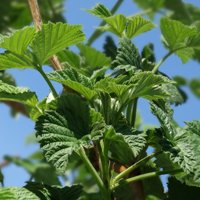![Размножение малины [Архив]](https://www.thymeinmygarden.com//img/razmnozhenie_malini_arhiv_forum_vinograd.jpg)
Lane Reproduction By Hair
 Malina is one of the most infamous and useful berry and its bushes are traditionally considered desirable by the inhabitants of any garden. Mining isn't that complicated. To this end, it is important to have suitable grade material, suitable location and conditions for landing and a little patience.
Malina is one of the most infamous and useful berry and its bushes are traditionally considered desirable by the inhabitants of any garden. Mining isn't that complicated. To this end, it is important to have suitable grade material, suitable location and conditions for landing and a little patience.
Sometimes gardeners wonder how to multiply the little one and how to do it better? In fact, the multiplication of the malina is possible both early spring and fall. Spring They sit before the kidneys grow, and at that time, they need regular irrigation for two weeks. In the fall, the Malian transplant takes place in the second half of September and until half, or the end of October.
It is difficult to say how to correctly unleash the small, since each class has its specific characteristics and the conditions of the particular terrain are influenced. In this case, the quality planting material chosen from healthy plants. There are several main ways of multiplying the man.
1. Small seed multiplication
The multiplication of small seeds is considered to be one of the most sensitive and patience-needed ways. Good mature berries are selected for quality seeds. They're being wiped and juice squeezed. In addition, in order to give the best seeds, the fur coats are wiped, watered and intermittent. The full seeds are falling down and the lungs float. Water with waste outbreaks is discharged and repeated several times. The seeds dry in the air. Now they're ready to eat. If they need to be stored for a while, they do so in the fridge at 1-5° C.
 The seeds shall be emitted to a depth of between 2 and 5 mm in the air soil, adding sand and peat. Increasing the productivity of seeds can be achieved through special processing. For this, seeds shall be smashed, in a 1:5 ratio, they shall be mixed with wet sand and placed in a drawer with fur, pre-packed on the hood. The box is kept in a dark room, for example, in a basement, at 2° C. The bags are sometimes demined by mixing sands and grains, and spraying water. Moch in the drawer should also be wet and good. Under such conditions, seeds are kept for 3 to 5 months. They then plant directly with the sand in the sand, enrich the soil with the peat, or in the boxes of greenhouses and greenhouses.
The seeds shall be emitted to a depth of between 2 and 5 mm in the air soil, adding sand and peat. Increasing the productivity of seeds can be achieved through special processing. For this, seeds shall be smashed, in a 1:5 ratio, they shall be mixed with wet sand and placed in a drawer with fur, pre-packed on the hood. The box is kept in a dark room, for example, in a basement, at 2° C. The bags are sometimes demined by mixing sands and grains, and spraying water. Moch in the drawer should also be wet and good. Under such conditions, seeds are kept for 3 to 5 months. They then plant directly with the sand in the sand, enrich the soil with the peat, or in the boxes of greenhouses and greenhouses.
The seed can be painted after a couple of real leaves appear. When the breeding of small seeds is done in the greenhouse, it is important to gradually flood them and to ensure that, in high humidity, the Senegalese do not suffer from mushroom diseases. When the first symptoms of disease or pest occur, infected seedlings are better destroyed.
Share this Post
Related posts
How To Plant Cucumbers In The Greenhouse
Tomatoes need a lower humidity of air, they are more comfortable with heat and soil flaw. With high air humidity, tomatoes…
Read MoreTomatoes In Heat Production
The tomatoes in the greenhouse have grown for over 40 years. Tested most of the classical recommendations described. But…
Read More









